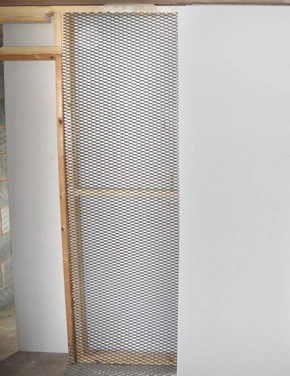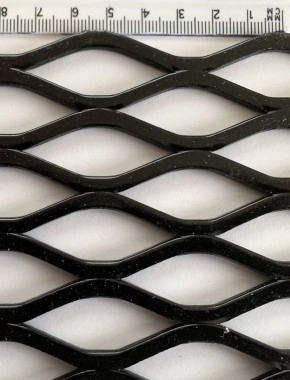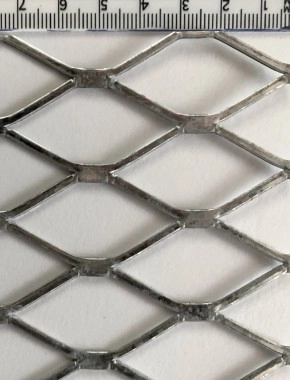Security Lathing
Secuity lath and plaster has been used to construct walls, partitions and ceilings in all kinds of security facilities including jails, shops, prisons, courtrooms, hospitals, data centres, banks and vaults. Intruders have found that the easiest access points to a building where the windows and doors have been guarded and alarmed is through weak partition walls and through the roof. The right choice of mesh significantly reduces the speed at which a would be burglar can gain access. The mesh must have an opening small enough that it is very difficult to get a pair of bolt crop teeth into the mesh. This is why expanded is ideal for the purpose as appose to welded meshes. The diamond shape makes it very awkward to cut with anything other than noisy power tools that would draw attention. The design that is recommended for this purpose comes in 2 thickness the standard medium thickness which is suitable for most environments and the heavy duty version which will give you more time when being attacked with power tools. The normal finish is mild steel appearance is not important as it will not be seen Galvanized is advised for an area where there is a chance of damp.
Security lathing and security walls
Studs, Channels and Rods
There are numerous steel sections which can be used to frame vertical and horizontal security elements. Steel studs are available in widths of 1-5/8" to 6" and in metal thickness of 25 gauge (0.0209") to 14 gauge (0.074"). Heavier gauge studs are preferred to facilitate welding and for producing stronger walls. Steel studs are available painted or fabricated from galvanised steel.
Expanded metal lath is available flattened, it comes in 2 versions as standard medium duty (MD1) or heavy duty (Hd1). Md1 is used in most circumstances, an example of a time HD1 would be used is the lathing within a walls protecting cash macines. It is supplied in mild steel as there are not generally issues with rust within a wall cavity, a galvanised finish is significantlly more expensive. Welded wire and woven wire laths are fabricated from galvanized wire can be used but there are much less secure as can be easily cut with hand tools. The expanded mesh is difficult to cut with bolt crops as the head of the cutters doesn't fit within the mesh apeture. Because of the unusually large open- ings in wire lath, Attach- ment of lath to steel framing is done with wire ties or self-tapping screws. Metallic laths are usually nailed or stapled to wood framing.
Expanded metal Lathing
Expanded metal is a rigid, non-raveling piece of metal which has been slit and drawn in a single operation. The expanded metal is stronger and more rigid than the original sheet, before expanding. It is too heavy and rigid to be used as a plaster base but provides a formidable barrier in the core of a plastered partition. Expanded metal security mesh is available in a standard or flattened pattern; carbon steel (plain or galvanized), stainless steel or aluminum in metal thickness of .030" to .119". The size (length andwidth) of the diamond openings designates the style.
The term SWD means short way of diamond and LWD means long way of diamond. These 2 figures give the shape of the diamond. SW is the strand width the distance between the diamonds. The thickness refers to the thickness of the original sheet before it was exanded. Tjis is the figure that is different between MD1 and Hd1 security lathing.
Plaster for security wall construction must not only be strong but must also be crack resistant and economical to apply. Authorities agree that a minimum 1400 psi plaster is desirable for security purposes.
Metal Lath Installation
A. Attach expanded metal lath to security mesh with wire ties not over 6" o.c. vertically and 16" o.c. horisontally.
B. Stagger end laps. Return lath 4 around comers or use comerite. Carry lath over concrete foundations at least 2”.
C. Direct attachment to steelstuds shall be made with wire ties or screws not over 6" o.c.
D. Attach lath to wood supports at furring points and not over 6" o.c.
A. Install casing beads, control joints, comer reinforcement and other metal plaster accessories to plaster line (using shims if necessary). Attach accessories bywire-tying, nailing or stapling through wings or holes provided. Attachment shall be strong enough to hold accessory in place during plastering operations.



